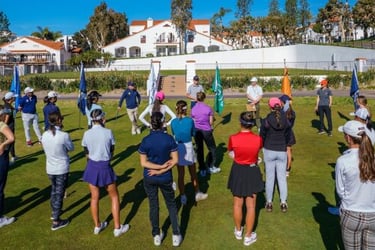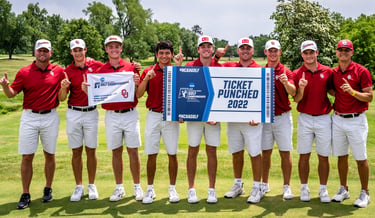

Photo: PGA of America
11/29/23 CollegeGolfCommits Staff
For a teenager who has spent thousands of hours over the years honing their craft on the links, their ultimate goal may be to play collegiate golf. For many, long days of practice, long car and plane rides, the highs and lows of tournament golf, and years of sacrifice can culminate with a scholarship. The path to a college scholarship is not always a linear process, and there are many different ways for a golfer to reach their final destination. The landscape of collegiate golf is vast, with hundreds of men’s and women’s programs at every level, from NCAA division I to division III, to NAIA and Junior College. Starting the recruiting process can be daunting, exciting, confusing, and overwhelming all at once, so we’ve gathered some recent college commits to answer some questions about the process. They represent a cross-section of highly regarded recruits going to top-25 ranked schools, Division III athletes, golfers heading to lower ranked Division I schools, an international signee, high academic candidates, and girls and boys from both the classes of 2024 and 2025.
EARLY RECRUITMENT
The first step in the recruitment process involves deciding which colleges might be the right fit for a golfer’s skill level and academic aspirations, then contacting coaches. It can be beneficial for a golfer to research how their scoring average and profile may fit in with a certain tier level of college teams, to determine where a realistic landing spot may be. Isabella Borte, who is committed to Division III Drew University, gave some insight into her research. ‘I tried to check out their top four players, and make sure I was somewhere within a few strokes of that realm, and the possibility of me playing there was actually realistic, before I reached out to coaches.’ Sophia Bardunias, a Division I 2024 signee to Bucknell University, concurred, ‘I would average out my tournament scores, then find the average scores of the top two scorers on the team and compare them. Then in my emails to coaches, I would include the average course yardage/rating that I was playing and my score versus their top players.’ Being a top-20 recruit in a class can change one’s perspective and approach, as shown by Avery McCrery’s methodology. McCrery is a 2025 graduate who is verbally committed to Duke University and is currently ranked #13 on Junior Golf Scoreboard. She states, ‘I never actually looked at stats such as scoring average before choosing my school. I measured my worth more against my peers in junior golf, many of which are some of the best amateurs in the country and measured my worth against them instead.’
There is no set timetable to make initial correspondence, but it is recommended to begin early and often. Spencer Stuke, a Tennessee Tech 2024 signee, reached out very early in the summer before his freshman year. ‘I sent about two emails a year, one after summer and one right before the spring school season started up. Things in my messages included points that would interest coaches, like scoring averages, weight room improvements, and any golf changes that I had since the last time I reached out.’ Delaney Nadeau, Division I Monmouth University signee, began filling out recruiting forms and reaching out to coaches in March of her sophomore year. She noted, 'My initial letter to almost all of the coaches I reached out to explained who I was, my game, my goals, my academic history, and why I was interested in their program. I followed up with those initial letters once or twice before June 15th letting them know what I had been working on and how any tournaments I had played in went.' Personalizing an email to a specific school is recommended, as coaches can recognize a generic email. Giving reasons why you are interested in the school and program is key. Ryan Chang, a 2024 commit to Ivy League University of Pennsylvania, had an older brother’s wisdom to follow. ‘I was fortunate to have an older brother who went through the recruiting process for track who advised me throughout my process. I started emailing coaches for schools that I was interested in as early as middle school. I think it was definitely helpful to introduce myself and it’s never too early to get on a coach's radar. I tried to follow up every couple of months with both academic and athletic achievements even when coaches couldn’t contact me before June 15th.’ Several golfers that we questioned took a different approach, taking their time to reach out and make sure their game was ready for coaches to look at. Ethan Blomme is the #1 2025 golfer in Iowa and is still in the recruiting process. He told us ‘I didn't reach out to coaches all of my sophomore summer, even past June 15th. For me, as a Midwestern player, I think the summer is the only time frame we have, and I wanted to wait for winter. Now that the whole golf season is done here in Iowa, I am starting to reach out to coaches. I’m mainly sending them any good golf and academic accomplishments, as well as my Junior Golf Scoreboard ranking and differential.’ Bucknell’s Bardunias started reaching out to coaches the summer of her sophomore year. ‘In the introductory messages, I introduced myself, where I was from, why I was interested in their school, and my GPA and average 18-hole score. From there I would update the coaches every two months, with either my most recent tournament scores and schedule or during the off-season what I was doing in practice to prepare for tournaments.’ That intermittent contact with coaches can be important to keep a golfer on their radar.


Top-20 recruit McCrery again took a different approach, prioritizing camps of colleges which she had already researched. Camps are an excellent way to meet and interact with coaches face-to-face earlier than the June 15th communication date, and this method is allowed by the NCAA. She provided some insight into her journey, ‘Before June 15th, I barely made any contact with teams or coaches. My family and I chose the route to go to various golf camps, and I decided to do some preliminary research on the schools. I knew that I wanted a finance degree, so I looked into the schools with good business and finance major programs, along with the school size and student teacher ratio. By doing that research to begin with. I narrowed down my list of schools I was interested in, and then focused my efforts on going to camps with coaches from those schools and trying to tour campuses as I traveled around the country for my golf tournaments. I reached out to the coaches of the camps I went to and thanked them, but other than that I tried to let my golf performances do the talking for me!’
Photo: NBC Sports
McCrery did a good amount of research into academics and school size, but what are other factors that lead athletes to narrow down their list of target schools? Class of 2025 Oklahoma commit Eli Walker Campbell’s focus was mainly on the aspects of the golf team. ‘The things that I looked for the most in choosing my school were the coaches, the facilities, and future teammates. The coaches are important because they can help me with certain shots, and they are someone that I will be in contact with for the rest of my life. The facilities are important because I want a place where I can work hard for hours and enjoy being there. My future teammates are important because I want the team to bond with each other well and get along well,’ he states. Tennessee Tech’s Stuke looked for the same qualities, in addition to a school with a good business program. South Africa’s Jack Buchanan, a 2024 LSU signee, had other requirements as an international recruit. ‘A big factor for me was weather. Coming from Cape Town, South Africa, where we can play golf all year round, I was definitely going to go to school somewhere where I can play all year round. All the schools I visited all had great team culture and world-class coaches. Once I found the ideal location for me in the SEC, it was all about my relationship with the coaches and the team.’
Borte had a unique situation, as she wanted to combine her loves for performing arts and golf in the same school, but relationships were equally important to her. She says, ‘The most important factor to me was finding a place that felt like home. I wanted a community, a team that rooted for each other, felt like a family, and worked hard to help each other grow. Academics were also a huge factor. I’ve always been super big into theatre and dance, and I’ve had the amazing opportunity to further my training at amazing places so far. I wanted to find a balance between athletics and academics, and a school that allowed me to thrive in both.’


The probability of making lineups is one factor to be considered, especially at a highly ranked golf program. Walker Campbell, McCrery, and Buchanan shared their perspective about it. ‘While it may be more challenging to go to a top ranked school and make lineups, I feel that it is a great challenge, and one of the things I like about a top ranked school. I’d rather have to put in hard work and earn my spot on the team rather than just being a shoo-in, as it pushes me to become better, and will probably gain respect from both my coaches and teammates,’ shared McCrery. Walker Campbell, whose brother currently plays at Oklahoma, shared her sentiment and feels that working hard to make lineups can be a similar experience to professionals who are making their way on tour. Buchanan had several top schools to choose from, but LSU, even with a high ranking, was the lowest ranked in that group. ‘It’s still a highly ranked school with world class facilities. I wanted to go to a school with a slightly smaller roster size, and LSU was able to offer that. I know if I’m playing well, I will make the team. I want to be around people that are going to push me to become better and for me, LSU is the best of both worlds. It’s a smaller team where I can hopefully get a lot of game time, while still competing against the best of the best in college golf,’ he added.
Photo: Sooner Sports


JUNE 15TH and the ACTIVE RECRUITMENT PHASE
Once golfers lay the groundwork of early emails and extensive research, that circled date on the calendar of June 15th after sophomore year brings recruiting to a whole new level. It can be a day of excitement but can be overwhelming for some and disappointing for others. The top ranked golfers will start getting emails right at midnight and texts, calls and emails may come by the dozens all day. Golfers who are still improving their skills for college may not receive any communication, and that’s okay. For some, that date may fall in the middle of a tournament, which happened to Bardunias and Walker Campbell. Both were smart and did not check their phones during play, but noted the experience was fun while checking their phones after their rounds. McCrery gives some good insight into her experience with some great organization tips, ‘June 15th was both an overwhelming and exciting experience. Before the day, my family and I had set up a spreadsheet to organize where schools would fall on my list (top. considering, stretch, etc) and to keep track of information I learned and what responses I had given. The most common way of reaching out was through email, although I did get some personalized messages from schools via text and phone call. By keeping track of who contacted me, where they fell on my list, and how much I wanted to go there, it was easier to choose which schools to set up calls with and respond to.’ South African Buchanan had to learn to schedule his time appropriately, being in a different time zone. ‘I remember June 15 well in my head. I had just finished writing my last midyear exam and remember my first phone call being with a South African coach, which was really cool. With the time difference it was hard to have many calls that evening, but within the next few days, more messages came in,’ he shared.
Another important part of recruiting is having coaches follow golfers in person. This can occur at any time before June 15th, but it significantly ramps up in that summer and beyond. Having a coach watch their game can cause a wide range of emotions in a golfer, and several golfers note they were afraid to ‘mess up’ at first but became more comfortable as time went on. Camryn Johnson, a 2024 grad who is committed to Division III Wayne State College, offered her perspective, ‘Being from such a small town where not many coaches attend high school golf meets, it was definitely a bit intimidating when coaches came to watch me golf. At first, I was very nervous because I didn’t want to mess up, but as I got more mature in my golf game, I became very confident in myself when coaches were watching me.’ Uncommitted Blomme states, ‘I had my first experience of a college coach coming to watch me in the final round of the 2023 Iowa Junior Amateur. When I saw him, I was a little nervous seeing him there, which caused some errant tee shots on the first couple of holes. After I got the small butterflies out, I was able to use it as motivation for myself, and that's the way I still look at it through this day once I've had more coaches looking at me.’ Tye Boone, who is signed to Division I Southern Indiana, told us ‘It definitely motivated me to work harder and prove myself, but I would be lying if I said it wasn’t a little intimidating.’ UPENN-bound Chang has a good take on the process, ‘It was definitely nerve-wracking the first couple times when coaches watched me play. Like any other junior golfer, you feel like you have to perform to give yourself a better chance. Although this is true, I soon realized that if the coaches are there to watch you, they are already interested and all you have to do is be yourself and to make sure to treat everyone around you with respect no matter how well you play.’ Borte was one of the few who was genuinely excited about being watched. ‘It motivated me! I wanted to show them my golf ability, of course, but I also wanted to show them my personality and strong desire to work hard as well. My dedication and work ethic are my strengths, and I knew that if I put in a lot of time and effort to build on my skills, then eventually results would come and coaches would see that.’
It can be strange to play in front of a coach who you can’t speak to in person, then talk to or text them on the phone immediately after a round. We talked to several athletes about the communication process, how often they talked to coaches, and how building relationships with coaches affected their college choices. One would think that the top recruits would be in contact with the greatest number of coaches at a more frequent rate, but we found that it was balanced between divisions and levels, as long as athletes were concentrating on schools in a tier that matched their skill level. Tennessee Tech’s Stuke reported, ‘I communicated with about 25 coaches throughout the recruiting process. I texted the coaches whose number I had about every week and then I emailed coaches on my contact list every other week. When I got my first offer, they put a time restraint on it, so I narrowed down my contacts by being direct and honest with them.’ Heading towards Division III, Borte made sure she cast a wide net, and it paid off in the end. ‘In the end I communicated with over 75 coaches, after 18 months had gone by. I emailed many of them and had phone calls or zoom calls with at least 50 of them. I would follow up every 2-5 weeks, and I did that from June of my Sophomore year to the beginning of my Senior year. I narrowed down my options by looking at many factors, with the top two factors being academic programs and if I could see myself in the community and playing for the golf program there,’ she said. For Buchanan, living in South Africa, communication was important because coaches could not see him play often. He shared, ‘I was fortunate enough to be speaking with quite a few coaches until I narrowed my list of schools I was interested in. It got to a stage where it was pretty much every night I had a call with a coach, and I had communication with coaches on the daily. I was able to narrow down my list after chatting to coaches for a while and was able to see if I thought the coach and school were a good fit. Obviously it’s very hard to do over a phone call or zoom, but I had to make it work.’ McCrery is one athlete that you would think would have a long list of coaches to talk to, but she was so laser focused and prepared prior to June 15th, that she narrowed her list quickly. ‘As it stood about two weeks after the initial date of reaching out, I was in contact with about five schools on a weekly basis, and from there just tried to gather from the coaches (and my prior research and other committed players) the gist of the culture on the golf team and at the school.’ Her family’s organization and early persistence were rewarded, as Avery was one of the early commits in the class of 2025. If a golfer’s goal is to play for a highly ranked academic school, they should have their transcript and current courseload readily available to coaches. UPENN signee Chang tells us ‘Because I’ve always had the goal to play at a school where I can receive the best education, the schools that I reached out to were all ranked very highly academically and had similar recruiting processes. With these schools, it was important to have all of my academic achievements (transcripts, test scores, etc) ready for the coaches to put me through a pre-read with the admissions committee to determine if was up to the standard academically before they could further continue discussions about golf recruitment.
‘I was fortunate enough to be speaking with quite a few coaches until I narrowed my list of schools I was interested in. It got to a stage where it was pretty much every night I had a call with a coach, and I had communication with coaches on the daily. I was able to narrow down my list after chatting to coaches for a while and was able to see if I thought the coach and school were a good fit.' -Jack Buchanan, LSU signee


VISITS and OFFERS
The next, and likely most fun part of recruiting after getting to know coaches is taking official visits. An official visit is a sign that a coach may be very interested in offering a scholarship or a roster spot on their team to an athlete, but it isn’t a guarantee. Both the athlete and coaches use the time to get to know each other, explore the facilities and campus together, attend a sports event, and determine if the team culture is a good fit. Some golfers are offered a scholarship on the spot, and others may be asked to wait until a decision has been made. Several commits were happy to share their official visit experiences. Walker Campbell, whose brother is on the team at Oklahoma, only needed one visit to know that OU is right for him, telling us ‘I had a great experience! I got to tour many of the athletic facilities and the dorms. My favorite part was getting to go to the football game and go on the field before the game.’ Johnson also had a positive experience on her visits. ‘My official visits were some of the greatest experiences I’ve had. To know that a coach wants you and they are willing to roll out the red carpet for you to come on a visit is a great feeling. To meet the coaches and learn about not only their golf programs, but also about the different majors each school has to offer is a great experience to have,’ she shared. Coming from South Africa, Buchanan was able to visit three schools in a similar geographic area in a short period of time. ‘I was able to visit three fantastic SEC schools. Each visit had something unique to it that made it stand out. I loved all three, and to be completely honest, visiting these schools made my decision 100 times harder. I had my “number one” school in my head before going to visit. I thought going to visit a few schools would make things easier to commit to one, but it made it that much harder to be sure about where I wanted to spend the next four years of my life,’ he said. Hopefully he will have a great experience in Baton Rouge! Stuke was our one contributor that didn’t need an official visit to make up his mind, as he was already familiar with Tennessee Tech. ‘My sister plays golf on the women's side for the school that I am going to. I visited her 4-5 times and saw the campus and how the team aspect worked. That was a critical factor in choosing whether to accept my offer or not.’ Like Walker Campbell’s situation, it helps to have a sibling with experience to share.


Photo: University of Illinois
Visits take a golfer one step closer to a commitment, and that next step can be an offer. We asked several golfers if they were given deadlines if they received an offer, and McCrery gave an excellent answer. ‘I felt no pressure to commit early, nor was I given any deadlines to commit. The reason I ended up committing early was up to my discretion. The preliminary research I had done, along with visiting camps really made official visits unnecessary for me, and I was ready to make my decision much earlier than most. Being a sought-after recruit is a good thing, and if you are a true top recruit, coaches will always go on your timeline. Always be wary of coaches trying to commit you early and giving you deadlines, as you must be ready to make your own decisions. Never let anyone pressure you into doing something you aren’t 100% sure about, especially when it affects your life for many years to come.’ Buchanan was able to cross one school off his list because of a deadline, ‘I didn’t feel any pressure to commit early, but once I knew for sure where I wanted to be, I committed. There was a school that gave me a deadline, but I was not able to come and visit before the coach wanted an answer. They were one of my top schools at the time, but I was certain that I wanted to visit the school before committing.’
Speaking of offers, we were curious to hear about commits’ experiences with turning down offers, which can be a difficult experience. Athletes have spent months developing relationships with coaches and saying ‘no’ to someone who has invested a lot of time and effort into them is tough. All three golfers who answered our question agreed that it was one of the hardest parts of the recruiting process. McCrery gives excellent advice, ‘It was extremely difficult for me to turn down the coaches I had made relationships with once I committed to Duke. Although I found it hard to say to them that their school was not my best fit, all coaches know that in the end there is only one school you can go to and are used to hearing the ‘bad news’. The most important thing is that you are cordial with all coaches when you break the news, and I made sure especially to contact all coaches and let them know before posting anything official, which is very important since no coach likes to be surprised. Although it may seem like any relationships you have with other coaches are over, if you are cordial and professional, you can still have a relationship with those coaches in the future.’ Buchanan appreciated the responses of several coaches, saying ‘Honestly It was extremely hard, up there with some of the hardest things I’ve had to do, full stop. Especially because you’re never 100% sure if you’re making the right decision or not. It was a bittersweet moment verbally committing, then having to call the other coaches that you had a good relationship with. At the end of the day, I have a lot of respect for a few coaches in particular that didn’t try guilt to trip me into feeling bad about not going to their school. Those that flew halfway across the world to watch me, or just those who I built up a good relationship with, I’m very thankful for the relationship that we built up.’ Finally, Borte expressed her appreciation to several coaches, ‘I was fortunate enough to meet so many supportive and encouraging coaches throughout the process that helped me and guided me in so many ways and having that conversation with them was definitely hard. But they were so understanding and supportive, even then, and knew I had to do what was best for myself and my future, and it was nothing personal.’
‘I felt no pressure to commit early, nor was I given any deadlines to commit. The reason I ended up committing early was up to my discretion. The preliminary research I had done, along with visiting camps really made official visits unnecessary for me, and I was ready to make my decision much earlier than most. Being a sought-after recruit is a good thing, and if you are a true top recruit, coaches will always go on your timeline. Always be wary of coaches trying to commit you early and giving you deadlines, as you must be ready to make your own decisions. Never let anyone pressure you into doing something you aren’t 100% sure about, especially when it affects your life for many years to come.’ - Avery McCrery, Duke University commit
ADVICE FOR LATE BLOOMERS
For all recruits the process of saying yes to their coach of choice comes before having to decline others, but the ability to make the initial commitment can be a longer process for some than others. Each golfer develops their game at their own pace, and some make strides in their game in the summer after their junior year instead of a year earlier. Seeing early commitments can be disheartening, but some of our participants offer a good perspective on their experience committing later in the process. Southern Indiana’s Boone, who recently committed, shared ‘I committed a little later in the process and absolutely I would say it was difficult seeing others committing early when I knew I could be doing the same. But you have to realize that your journey is different and that you just have to stick with what you are doing and not compare yourself to others.’ Recent Drew University commit Borte had a good support system behind her, saying ‘It was difficult to see, however I knew what I wanted, and I knew it was going to take a bit to get there. I was willing to put the work in, and I knew that it was all going to come within myself and the effort I put in between then and now. I had amazing parents, golf friends, and mentors who pushed me and encouraged me to keep going, and always believed in me along the way. I couldn’t be more grateful for them as well.’ Borte, along with recent Wayne State College commit Johnson offer some sound advice to those late bloomers in the same boat. ‘My advice to golfers who are still developing their game would be to never stop trying and working hard. Being a golfer from a very small school who didn’t have the resources like some of the other golfers in my state made it very hard to develop my game at the same rate as some other girls. With the recruiting process, never stop trying and working for your goals. I got to a point where I realized that I am just a little bit behind everyone else, but I can still go to a Division II school and leave an impact there. I also know that there is still time for me to get better at the game and still accomplish my goal of competing at the Division I level,’ says a positive Johnson. Borte adds, ‘I think that maybe having a setback, or something or someone holding you back and telling you that you aren’t good enough can be the best form of motivation. Work even harder, put in so much effort, and prove them wrong. You can achieve what you want if you work hard. There is a school out there for everyone, and so many schools that want a good, hard worker over a good golfer.’ Monmouth’s Nadeau adds some excellent advice to the discussion with ‘I don't think I was necessarily developing my game later as much as I was not always playing to the level expected and achieved in the past, which makes communicating with and pitching yourself to coaches extremely difficult. The best thing that I did at this point was sit down and write letters to the coaches at the programs I was still talking to that I felt I hadn't shown them enough of why I deserved a spot on my team. I explained to them all I had been doing, the mental toll the recruiting process had taken on me, and what I planned to do to be sure that I was ready to help their team come fall of 2024. After I sent these letters, I told myself there was nothing else I could do aside from just have fun and enjoy playing the game again. I was headed into my senior year of high school and wanted to be able to enjoy the golf season and school without constantly stressing about where I was going to end up. It ended up paying off for me and the coaches all really appreciated the effort I gave to explain my situation and feelings to them.’ Lastly, Stuke offers some guidance to golfers who may not get the offer that they are hoping for. ‘Don't be afraid of JUCO. Junior College is a great route that will show if you have it or not. If you are truly dedicated to your craft and want to get better, then after two years at JUCO you can get the looks you want.’


THOUGHTS and ADVICE
We asked our participants to choose three words to describe their recruiting experience. Exciting and stressful were common adjectives, in addition to a variety of other responses, negative and positive. Bucknell’s Bardunias went through a variety of emotions in the recruiting process, saying ‘Exciting, because it was always something that I had heard about, and a goal of mine was always to play college golf. The chance to actually commit and achieve that goal was exciting. Surprising: The school that I ended up committing to wasn't the type of school that I had originally pictured myself at, but once I visited, I immediately fell in love with the school and couldn't see myself anywhere else. Nerve-wracking: At the beginning I was worried that I wouldn't get recruited, but as time went on those nerves calmed and I was able to be more confident in myself.’ Boone’s experience differed, as it wasn’t always a smooth process for him, as he chose stressful, time-consuming, and awkward to describe his experience. ‘It was stressful because you see everyone else posting their commitments on social media and you feel like you are behind in the process. Emails and texts take time, and you have to think about what you want to say. And very awkward because you just don’t know what the coaches are thinking about and what they want to hear from you,’ he shared. Tennessee Tech’s Stuke's three words were ‘constant, persistence, and faithfulness.’ He noted, ‘It was constant because you could always do more. There were always more emails to send, coaches to text, or research to do. Recruiting is always on your mind, whether at school or in a tournament. I chose persistence because you have to keep going even when you don’t get the responses you want. Unless you are a top player, you will undoubtedly get responses that are negative or just straight up no. I believe that unless the answer is no, you have to keep going. The last thing is faithfulness, because I had to lean on my faith in God a lot to direct me on the right path. This is not a process you want to do by yourself, so leaning on other things like my family or my faith was a huge help for me.’ Shlok Jain, a High Point University signee, concluded ‘Discipline, Frustrating, Fulfilling. I chose these words because one has to be disciplined and consistent in their efforts to reach out to coaches and work on their game for tournaments. It can be frustrating sometimes when we don't get the desired results or hear back from coaches, and it is fulfilling in the end when you get rewarded for the work you've put into it.’ Other adjectives that athletes chose were ‘meant to be’, enjoyable, thrilling, learnable, and challenging.
Finally, we close out the journey of recruiting with advice from several of our participants, all who hope to help others with their own journeys through this exciting time in their lives.
Johnson: I would give a prospective recruit the advice to stay patient in this process and trust that the right path will come to you eventually. Yes, it can be hard to hear a no from your dream school, but everything happens for a reason, and it will all be okay in the end if you believe in yourself and the hard work you have put in.
McCrery: The best advice I can give to perspective recruits is to be yourself and fall in love with the game. The greatest thing that ever happened to me before the recruiting process was learning to love golf and breaking away from my family to become my own athlete and person. Colleges are recruiting you, and to love the game and grow yourself are vital to being genuine and learning how to participate with a team of like-minded athletes.
Boone: Don’t worry about what your peers are doing and posting. Everyone has their own journey and yours will be different than others, so it does you no good to compare what they have done to what you have.
Buchanan: Enjoy the process, because it only happens once. Don’t feel rushed to commit somewhere because coaches are pressuring you into committing early. Take your time and try being as confident as you can be in your final decision.
Chang: Trust the process! You will end up where you are meant to be. Be as proactive as possible and be yourself. You don’t want to fake it and not have a great time at what most people say are the best four years of their lives!
Nadeau: My biggest piece of advice would be to make sure you always remember your love for the game and are reminded that the division or the ranking is so much less important than finding a program where you feel welcomed and supported. The process will be stressful, intimidating, and overwhelming, but be sure to play for fun and enjoying it will make it more manageable.
Borte: Be patient, trust, and have confidence! I know it may seem very hard and may seem like you can’t do it at times, but YOU CAN! You wouldn’t be pursuing this if you didn’t think it was right for you and it was something you could make happen.
Thank you to the 12 athletes who took the time to give thorough and comprehensive answers to many of our questions. Your advice and insight will help many recruits and their families navigate the recruiting process!
Camryn Johnson 24: Division III Wayne State College
Eli Walker Campbell 25: Division I top-25 golf program University of Oklahoma
Spencer Stuke 24: Division I Tennessee Tech University
Avery McCrery 25: Division I top-25 golf and academic program Duke University
Isabella Borte 24: Division III Drew University
Ryan Chang 24: Division I Ivy League University of Pennsylvania
Jack Buchanan 24: Division I top-50 golf program Louisiana State University
Tye Boone 24: Division I University of Southern Indiana
Delaney Nadeau 24: Division I Monmouth University
Shlok Jain 24: Division I High Point University
Sophia Bardunias 24: Division I Bucknell University
Ethan Blomme 25: in recruitment process
'Trust the process! You will end up where you are meant to be. Be as proactive as possible and be yourself. You don’t want to fake it and not have a great time at what most people say are the best four years of their lives!' -Ryan Change, UPENN signee

